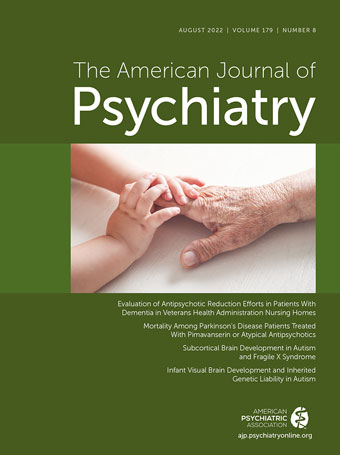Autism spectrum disorder (ASD) and fragile X syndrome are neurodevelopmental disorders with very different etiologies that are known to have overlapping symptoms, both associated with marked changes in behavior and a range of alterations in intellectual development as well as high levels of comorbid pathological anxiety. In contrast to ASD, which most commonly involves mutations in various risk genes and chromosomal copy number variants (
8), fragile X syndrome is due to mutations in the FMR1 gene, which, when expressed in the brain, encodes for a protein thought to be involved in synaptic development. Various abnormalities in brain development are well-known to occur in young children with ASD and fragile X syndrome. For example, previous work has identified altered amygdala development, characterized by increased size during early childhood, to be associated with ASD. The amygdala is of particular interest as it is involved in mediating fear- and anxiety-related behaviors as well as in contributing to social behavior. Differing from ASD, fragile X syndrome has been associated with aberrant development of the caudate. In this issue, Shen and colleagues (
9) report data from a longitudinal imaging study examining the early-life development of select brain regions including the amygdala and caudate in infants at risk for developing ASD, infants with fragile X syndrome, and control infants. Infants were studied as participants in the Infant Brain Imaging Study Network and were considered to be at risk for ASD if they had a sibling with confirmed ASD. Infants were initially scanned at 6 months of age and then again at 12 months and 24 months. At 24 months the at-risk ASD participants were assessed as to whether they met criteria for ASD. Results demonstrated that when comparing at-risk infants that did not develop ASD (N=212), fragile X syndrome infants (N=29), and control infants (N=109), the at-risk infants that developed ASD (N=58) had significantly greater amygdala volumes at 12 and 24 months. In contrast, the fragile X syndrome infants demonstrated increased volume of the caudate, putamen, and globus pallidus at 6, 12, and 24 months of age. In addition to the group differences, at the individual level, more rapid amygdala growth from 6 to 12 months predicted the magnitude of social deficits in the infants that developed ASD at 2 years of age. Conversely, individual differences in caudate volume at 12 months of age predicted greater repetitive behaviors in fragile X syndrome infants at 24 months of age. Taken together, these findings lend insights into alterations in different brain regions and developmental time courses that are associated with ASD and fragile X syndrome. Of particular interest is the finding that early-life amygdala overgrowth precedes the onset of social deficit symptoms in infants that later develop ASD. This points to the possibility of using the trajectory of early-life amygdala development as a neural marker of risk as well as a potential early-life treatment target. In their editorial, Drs. David Amaral and Christine Nordahl from the University of California at Davis (
10) provide a discussion of the findings from this paper and an in-depth discussion of the amygdala as it may relate to mediating ASD-related social deficits. They also discuss potential mechanisms that may underlie altered amygdala development and comment on data from their own work suggesting that there are different patterns of altered amygdala development in autistic children, which may be important in understanding the heterogeneity of symptoms experienced by ASD individuals.

